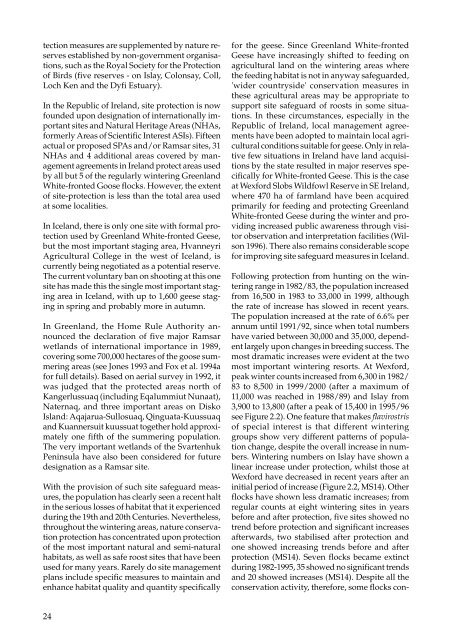The Greenland White-fronted Goose Anser albifrons flavirostris
The Greenland White-fronted Goose Anser albifrons flavirostris
The Greenland White-fronted Goose Anser albifrons flavirostris
You also want an ePaper? Increase the reach of your titles
YUMPU automatically turns print PDFs into web optimized ePapers that Google loves.
tection measures are supplemented by nature reserves<br />
established by non-government organisations,<br />
such as the Royal Society for the Protection<br />
of Birds (five reserves - on Islay, Colonsay, Coll,<br />
Loch Ken and the Dyfi Estuary).<br />
In the Republic of Ireland, site protection is now<br />
founded upon designation of internationally important<br />
sites and Natural Heritage Areas (NHAs,<br />
formerly Areas of Scientific Interest ASIs). Fifteen<br />
actual or proposed SPAs and/or Ramsar sites, 31<br />
NHAs and 4 additional areas covered by management<br />
agreements in Ireland protect areas used<br />
by all but 5 of the regularly wintering <strong>Greenland</strong><br />
<strong>White</strong>-<strong>fronted</strong> <strong>Goose</strong> flocks. However, the extent<br />
of site-protection is less than the total area used<br />
at some localities.<br />
In Iceland, there is only one site with formal protection<br />
used by <strong>Greenland</strong> <strong>White</strong>-<strong>fronted</strong> Geese,<br />
but the most important staging area, Hvanneyri<br />
Agricultural College in the west of Iceland, is<br />
currently being negotiated as a potential reserve.<br />
<strong>The</strong> current voluntary ban on shooting at this one<br />
site has made this the single most important staging<br />
area in Iceland, with up to 1,600 geese staging<br />
in spring and probably more in autumn.<br />
In <strong>Greenland</strong>, the Home Rule Authority announced<br />
the declaration of five major Ramsar<br />
wetlands of international importance in 1989,<br />
covering some 700,000 hectares of the goose summering<br />
areas (see Jones 1993 and Fox et al. 1994a<br />
for full details). Based on aerial survey in 1992, it<br />
was judged that the protected areas north of<br />
Kangerlussuaq (including Eqalummiut Nunaat),<br />
Naternaq, and three important areas on Disko<br />
Island: Aqajarua-Sullosuaq, Qinguata-Kuussuaq<br />
and Kuannersuit kuussuat together hold approximately<br />
one fifth of the summering population.<br />
<strong>The</strong> very important wetlands of the Svartenhuk<br />
Peninsula have also been considered for future<br />
designation as a Ramsar site.<br />
With the provision of such site safeguard measures,<br />
the population has clearly seen a recent halt<br />
in the serious losses of habitat that it experienced<br />
during the 19th and 20th Centuries. Nevertheless,<br />
throughout the wintering areas, nature conservation<br />
protection has concentrated upon protection<br />
of the most important natural and semi-natural<br />
habitats, as well as safe roost sites that have been<br />
used for many years. Rarely do site management<br />
plans include specific measures to maintain and<br />
enhance habitat quality and quantity specifically<br />
24<br />
for the geese. Since <strong>Greenland</strong> <strong>White</strong>-<strong>fronted</strong><br />
Geese have increasingly shifted to feeding on<br />
agricultural land on the wintering areas where<br />
the feeding habitat is not in anyway safeguarded,<br />
'wider countryside' conservation measures in<br />
these agricultural areas may be appropriate to<br />
support site safeguard of roosts in some situations.<br />
In these circumstances, especially in the<br />
Republic of Ireland, local management agreements<br />
have been adopted to maintain local agricultural<br />
conditions suitable for geese. Only in relative<br />
few situations in Ireland have land acquisitions<br />
by the state resulted in major reserves specifically<br />
for <strong>White</strong>-<strong>fronted</strong> Geese. This is the case<br />
at Wexford Slobs Wildfowl Reserve in SE Ireland,<br />
where 470 ha of farmland have been acquired<br />
primarily for feeding and protecting <strong>Greenland</strong><br />
<strong>White</strong>-<strong>fronted</strong> Geese during the winter and providing<br />
increased public awareness through visitor<br />
observation and interpretation facilities (Wilson<br />
1996). <strong>The</strong>re also remains considerable scope<br />
for improving site safeguard measures in Iceland.<br />
Following protection from hunting on the wintering<br />
range in 1982/83, the population increased<br />
from 16,500 in 1983 to 33,000 in 1999, although<br />
the rate of increase has slowed in recent years.<br />
<strong>The</strong> population increased at the rate of 6.6% per<br />
annum until 1991/92, since when total numbers<br />
have varied between 30,000 and 35,000, dependent<br />
largely upon changes in breeding success. <strong>The</strong><br />
most dramatic increases were evident at the two<br />
most important wintering resorts. At Wexford,<br />
peak winter counts increased from 6,300 in 1982/<br />
83 to 8,500 in 1999/2000 (after a maximum of<br />
11,000 was reached in 1988/89) and Islay from<br />
3,900 to 13,800 (after a peak of 15,400 in 1995/96<br />
see Figure 2.2). One feature that makes <strong>flavirostris</strong><br />
of special interest is that different wintering<br />
groups show very different patterns of population<br />
change, despite the overall increase in numbers.<br />
Wintering numbers on Islay have shown a<br />
linear increase under protection, whilst those at<br />
Wexford have decreased in recent years after an<br />
initial period of increase (Figure 2.2, MS14). Other<br />
flocks have shown less dramatic increases; from<br />
regular counts at eight wintering sites in years<br />
before and after protection, five sites showed no<br />
trend before protection and significant increases<br />
afterwards, two stabilised after protection and<br />
one showed increasing trends before and after<br />
protection (MS14). Seven flocks became extinct<br />
during 1982-1995, 35 showed no significant trends<br />
and 20 showed increases (MS14). Despite all the<br />
conservation activity, therefore, some flocks con-


